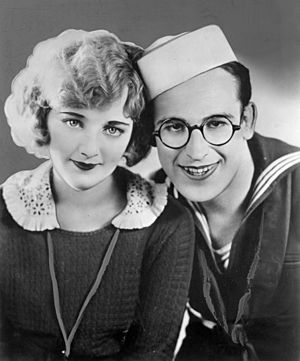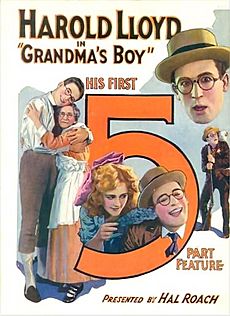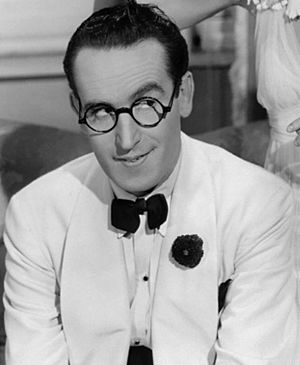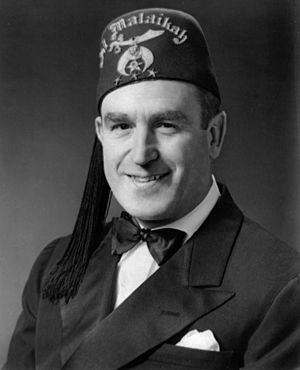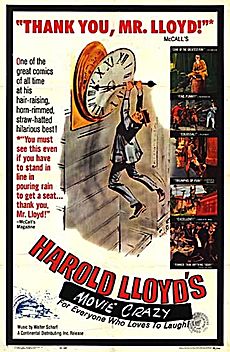Harold Lloyd facts for kids
Quick facts for kids
Harold Lloyd
|
|
|---|---|
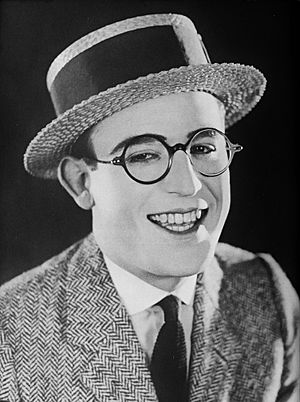
Lloyd in 1924
|
|
| Born |
Harold Clayton Lloyd
April 20, 1893 Burchard, Nebraska, U.S.
|
| Died | March 8, 1971 (aged 77) |
| Resting place | Forest Lawn Memorial Park |
| Occupation |
|
| Years active | 1913–1963 |
| Spouse(s) |
Mildred Davis
(m. 1923; died 1969) |
| Children | 3, including Harold Lloyd Jr. |
Harold Lloyd (born April 20, 1893, died March 8, 1971) was a famous American actor, comedian, and stunt performer. He starred in many silent comedy films.
Harold Lloyd was one of the most important comedians of the silent movie age. He made nearly 200 comedy films between 1914 and 1947. These included both silent movies and "talkies" (movies with sound). His most famous character wore glasses and was a clever, ambitious person. This character fit perfectly with the spirit of the 1920s in the United States.
His movies often had exciting "thrill scenes" with long chases and daring stunts. One of the most famous images in movie history is Lloyd hanging from a giant clock high above a street in his film Safety Last! (1923). Lloyd did many of his own stunts. However, he had an accident in 1919 while taking pictures for his studio. A prop bomb exploded, and he lost a thumb and a finger on his right hand. He wore a special glove in his future films, so his injury was almost impossible to see on screen.
Contents
Early Life and Beginnings
Harold Lloyd was born on April 20, 1893, in Burchard, Nebraska. His parents were James Darsie Lloyd and Sarah Elisabeth Fraser. His family had roots in Wales. In 1910, his parents divorced after his father had some business problems. Harold moved with his father to San Diego, California, where he went to San Diego High School.
From a young age, Lloyd was interested in theater. He worked with acting groups and often tried out different makeup styles to make himself look older.
A Star's Journey
Harold Lloyd started his movie career working for Thomas Edison's film company. His first small role was as a Yaqui Indian in a movie called The Old Monk's Tale. When he was 20, Lloyd moved to Los Angeles. He took on small roles in comedies made by the Keystone Film Company.
He tried to get work at Universal studio. He later remembered that the guard at the gate was not friendly. But Lloyd used his cleverness, just like his future movie characters. He brought a makeup box, changed his look behind a billboard, and walked in with other actors without being stopped.
Meeting Hal Roach
Soon, Lloyd became friends with a young filmmaker named Hal Roach. Roach started his own studio in 1913, and Lloyd began working with him. Together, they created a funny character called "Lonesome Luke." This character was inspired by the popular comedian Charlie Chaplin. Luke wore funny clothes and a fake mustache. Harold Lloyd brought a lot of energy to the character, and his short comedies became very popular.
Hal Roach hired Bebe Daniels in 1914 to act alongside Lloyd. Lloyd and Daniels became a couple and were known as "The Boy" and "The Girl."
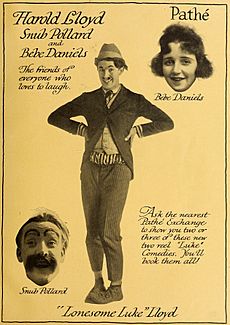
The "Glass" Character is Born
By late 1917, Lloyd wanted to try something new. He was tired of playing Lonesome Luke. He wanted to create a different character, not a clown in a costume, but an everyday young man. This new character would wear regular clothes and use his smarts to get out of funny situations. To make this new character stand out, Lloyd decided he would wear a pair of glasses without lenses.
Lloyd worried that the movie company, Pathé, would not like the new character because Lonesome Luke films were making a lot of money. But Roach convinced them to give it a try. Lloyd agreed to keep making Lonesome Luke films while also introducing his new "Glass" character in shorter, less expensive movies. As the new character became popular, Lonesome Luke slowly disappeared.
The "Glass" character was often named "Harold" in the silent films. This character was more grown-up and had deeper feelings, which made it easy for audiences to connect with him. Lloyd explained in an interview that wearing the glasses made him seem more like a real person. He said, "He was a kid that you would meet next door... but at the same time I could still do all the crazy things that we did before, but you believed them."
Unlike many other silent comedy characters, "Harold" wasn't stuck in one social class. He was always trying to succeed and be recognized. He played characters from a poor wanderer to a rich socialite.
In 1919, Bebe Daniels left to pursue other acting roles. Lloyd then replaced her with Mildred Davis, who he would later marry. Lloyd was told by Roach to watch Davis in a movie. He liked her more and more, thinking she looked like a "big French doll."
The Accident and Feature Films
On August 24, 1919, while taking pictures for a movie, Harold Lloyd picked up what he thought was a fake bomb. It exploded and badly injured his right hand, causing him to lose a thumb and a finger. Luckily, his eyesight was not harmed. The explosion was strong enough to injure the cameraman and prop director nearby as well. Lloyd later said he thought he might never be able to work again, but he was just happy to be alive.
Starting in 1921, Roach and Lloyd began making longer comedies called feature films. These included the popular Grandma's Boy and the very famous Safety Last! (1923). Safety Last! made Lloyd a huge star. It is also one of the oldest films on the American Film Institute's list of 100 Most Thrilling Movies. Even though Lloyd did many athletic stunts, Harvey Parry was his stunt double for the most dangerous parts.
Lloyd and Roach stopped working together in 1924. Lloyd then started his own company, the Harold Lloyd Film Corporation. He made only feature films, which were released through Pathé and later Paramount. Some of his best comedies from this time include Girl Shy, The Freshman (his highest-earning silent film), The Kid Brother, and Speedy, which was his last silent movie. These films were very successful, and Lloyd became the highest-paid movie star of the 1920s.
Sound Films and Later Years
In 1929, Harold Lloyd finished a silent film called Welcome Danger. But by then, movies with sound had become very popular. So, he decided to remake the entire film with sound. Welcome Danger was a big success, as audiences were excited to hear Lloyd's voice.
Lloyd successfully made the change to sound films. He made several talking comedies, including Feet First, where he again clung to a skyscraper. Other films included Movie Crazy and The Milky Way.
However, Lloyd's cheerful, go-getting movie character didn't connect as well with audiences during the Great Depression of the 1930s. He made fewer films, and his popularity slowly went down. His last film of the decade was Professor Beware (1938).
In 1937, Lloyd sold the land where his movie studio was located to the Church of Jesus Christ of Latter-day Saints. Today, it is the site of the Los Angeles California Temple.
Lloyd produced a few comedies in the early 1940s, but mostly retired from acting until 1947. He returned for one more starring role in The Sin of Harold Diddlebock. This film was meant to honor Lloyd's career. It even started with scenes from his earlier film The Freshman. However, Lloyd and the director, Preston Sturges, had different ideas for the movie, and it was not very successful.
Radio and Community Work
In 1944, Lloyd became the director and host of The Old Gold Comedy Theater, a radio show. The show presented short radio versions of popular film comedies. It featured many famous actors and radio stars of the time. The show ended in 1945.
Harold Lloyd was also very involved in community and charity work. After his own serious injuries, he became very active with the Shriners Hospital for Crippled Children. He was a high-ranking member of the Shriners and was even chosen as their Imperial Potentate for 1949–50. At his installation ceremony, 90,000 people were there, including U.S. President Harry S Truman.
Lloyd appeared as himself on several television shows during his retirement. He was a mystery guest on What's My Line? and appeared on This Is Your Life multiple times.
Lloyd also enjoyed photography, including 3D photography and color film experiments. He encouraged and supported many younger actors, like Debbie Reynolds and Jack Lemmon.
Renewed Interest in His Work
Lloyd kept the rights to most of his films and did not often re-release them after he retired. He didn't want his silent films shown without proper musical accompaniment. Also, his price for showing his films on television was very high. Because of this, his fame and public recognition were not as strong as other silent film stars like Charlie Chaplin and Buster Keaton.
In the early 1960s, Lloyd created two compilation films, Harold Lloyd's World of Comedy and The Funny Side of Life. These films showed scenes from his old comedies. The first film was shown at the 1962 Cannes Film Festival, where Lloyd was celebrated. This new interest helped bring back his status among film historians. He often showed his films to audiences at special events, especially at colleges, where he found a very welcoming audience.
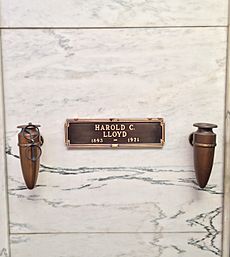
After his death, most of his feature films were leased to Time-Life Films in 1974. These versions were sometimes edited for TV. In 1990, a documentary called Harold Lloyd: The Third Genius helped renew interest in his work in the United States.
In 2002, the Harold Lloyd Trust began re-releasing his films. New versions of his silent features and short films were created with new orchestral music. These versions are often shown on the Turner Classic Movies (TCM) channel. A DVD collection of these restored films was released in 2005.
Personal Life
Lloyd married his leading lady, Mildred Davis, on February 10, 1923, in Los Angeles, California. They had two children, Gloria Lloyd (born 1923) and Harold Clayton Lloyd Jr. (born 1931). They also adopted Gloria Freeman (born 1924), who they renamed Marjorie Elizabeth Lloyd. Lloyd did not want Davis to continue her acting career. Mildred Davis died in 1969 from a heart attack. Harold Jr. died from problems related to a stroke three months after his father.
In 1925, Harold Lloyd became a Freemason. He quickly moved up in the organization and joined the Al Malaikah Shrine in Los Angeles. He was very dedicated to this group.
Lloyd's home in Beverly Hills, "Greenacres", was built between 1926 and 1929. It was a huge house with 44 rooms, 26 bathrooms, 12 fountains, 12 gardens, and a nine-hole golf course. In 1943, a fire in his film vault destroyed some of his silent films. Lloyd himself was saved by his wife, who pulled him to safety. The main house was not damaged. The Lloyd family sold the estate in 1975. The main house and gardens are still there and are often used for events and filming. It is listed on the National Register of Historic Places.
Death and Legacy
Harold Lloyd died from prostate cancer on March 8, 1971, at his Greenacres home in Beverly Hills, California. He was 77 years old. He was buried in a crypt at Forest Lawn Memorial Park Cemetery in Glendale, California. His former co-star Bebe Daniels died eight days after him, and his son Harold Lloyd Jr. died three months later.
Honors and Recognition
In 1927, Harold Lloyd was honored at Grauman's Chinese Theatre. His handprints, footprints, and autograph were preserved in concrete, along with the outline of his famous glasses.
In 1953, Lloyd received an Academy Honorary Award for being a "master comedian and good citizen."
In 1960, Lloyd received a star on the Hollywood Walk of Fame for his contributions to movies. In 1994, he was honored with his image on a United States postage stamp.
Lloyd's birthplace in Burchard, Nebraska, is now a museum that you can visit by appointment.
Filmography
See also
 In Spanish: Harold Lloyd para niños
In Spanish: Harold Lloyd para niños
- List of American comedy films
- List of notable Freemasons


